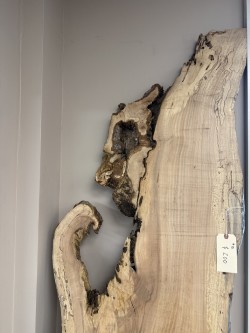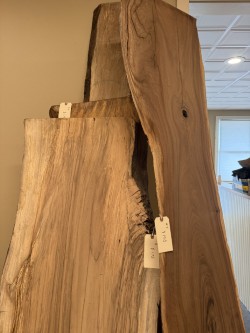

It’s safe to say everyone is in a craze over live edge wood. With its organic shapes, raw beauty, and one-of-a-kind appeal, live edge wood has become a standout feature in modern home décor. Whether used for large furniture pieces or smaller accents, live edge wood brings warmth, character, and a touch of nature indoors.
What Is Live Edge Wood?
Live edge wood is exactly what it sounds like—lumber that retains the tree’s original edge rather than being milled to a uniform shape or size. The “live” edge refers to the unfinished, natural contour of the wood slab, often preserving elements of the bark and unique curvature of the tree.
While live edge pieces are sometimes made from reclaimed wood, most available slabs today come from freshly cut timber, though reclaimed live edge options do exist (and are rarer).
Common Wood Types
Although any species of wood can be used for live edge furniture, a few are more common because of their appearance and workability:
-
Oak – Affordable and widely available, oak slabs range from pale to dark brown and are known for their durability.
-
Maple – A hardwood often displaying beautiful grain patterns, ranging in color from light tan to rich brown.
-
Cherry – Less common but visually stunning, cherry wood deepens in color over time, transitioning from soft pink-hues to deep reds or browns.
-
Mahogany – Recognized for its deep, reddish-brown tones, mahogany offers richness and elegance.
-
Walnut – A favorite for its dark, wavy grain; harder to work with but produces stunning results.
-
Hickory – Light yellow in tone with a straighter grain; darkens beautifully as it ages.
Types of Live Edge Cuts
Live edge wood comes in three main cuts, each suited for different projects:
-
Slabs – Cut lengthwise from the tree, slabs typically feature live edges on two sides, making them ideal for tables and countertops.
-
Slices (Rounds) – Cut horizontally, these display the tree’s growth rings and have a natural edge all around—perfect for smaller pieces like side tables.
-
Burls – Formed from deformed tree growths, burls are rare and highly prized for their striking, irregular patterns and sculptural appearance.
Choosing and Buying Live Edge Wood
Before purchasing live edge wood, consider its purpose. Will it be a dining table, a shelf, or a mantel? The intended function determines the type of wood, cut, and finish you’ll need.
Creative Ways to Use Live Edge Wood
Once you’ve found the perfect slab, there’s no limit to how you can incorporate it into your home décor:
-
Dining Tables – A live edge dining table makes a stunning focal point, blending rustic beauty with modern design.
-
Coffee & Side Tables – Unique edges and wood grains make each piece a conversation starter.
-
Shelving – Live edge shelves add organic warmth and practicality to any room.
-
Headboards – The natural patterns create a calming, nature-inspired bedroom feature.
-
Desks – Perfect for home offices, combining creativity with craftsmanship.
-
Countertops & Bars – Bring the outdoors in with a live edge kitchen island or bar top.
-
Wall Art & Mirrors – Showcase the raw edge as part of an artistic design element.
-
Benches – Functional, stylish, suitable for both indoor and outdoor spaces.
-
Mantels – A live edge mantel adds warmth and texture to your fireplace area.
-
Cutting Boards & Serving Trays – Even smaller live edge accents can elevate your kitchen’s aesthetic.
Bringing It All Together
Live edge wood is more than just a design trend—it’s a celebration of nature’s artistry. Each piece tells the story of the tree it came from, with unique grain patterns and contours that make it truly one-of-a-kind. Whether you’re creating a show-stopping dining table or adding subtle natural accents, live edge wood effortlessly bridges the gap between rustic charm and modern design.



Sources:
Content adapted from:
-
“Creative Uses for Live Edge Wood in Home Décor” from Live Edge Pro.
-
“What Is Live Edge Wood?” from Michigan Reclaimed Barns Blog.
.png)